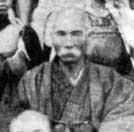Itosu, Anko (Yasutsune) (1831-1915)
By Tom Ross
 Itosu was born in the Gibo section of Shuri Okinawa in 1831 and died on January 26, 1915 . His first name was Anko, (the Kanji for which may be alternately read in Japanese as Yasutsune). He was born to a prominent family and was well educated in the classics of Chinese literature. Up until recently there were no known photos of him, only descriptions. Recently, however, an image of him was discovered in a group photo. He is seen as an aging gentelman. Itosu was born in the Gibo section of Shuri Okinawa in 1831 and died on January 26, 1915 . His first name was Anko, (the Kanji for which may be alternately read in Japanese as Yasutsune). He was born to a prominent family and was well educated in the classics of Chinese literature. Up until recently there were no known photos of him, only descriptions. Recently, however, an image of him was discovered in a group photo. He is seen as an aging gentelman.
He was short by modern standards but in Okinawa during the time his approximately
five feet of height was normal. By all accounts he was built strongly
and there are many tales of his incredible punching ability.
Itosu began to study the martial arts under the watchful eye of Nagahama
Chikudon Peichin. After taking and passing civil services exams he became
a clerk for the Ryukyu government. It was through the assistance of his
good friend Anko Azato that he would rise to a position of prominence
in Ryukyu governmental administration.
Itosu continued his training in the martial arts with Matsumora Kosaku
and allegedly the cave dwelling "ANAN" in 1873 (Sakagami). He
may, in fact, have begun training with the legendary Sokon "Bushi"Matsumura
when in his late thirties (Fujiwara 1990) after an introduction from his
father who had become friends with the Bushi (Iwai 1992).
It is through the efforts of this "Father of Modern Karate"
that many basic exercises and forms were simplified and organized into
a curriculum suitable for the mass instruction of students. In addition
to placing importance on basics, Itosu took the Channan forms he had previously
devised (or had been taught him, according to historians) and after having
altered some of the movements he renamed them Pinan which he thought would
be more appealing to students. This is evidenced in such Journals as "Karate
No Kenkyu" by Nakasone genwa 1934 and "Kobo Kenpo Karate-do
Nyumon" by Mabuni Kenwa and Nakasone Genwa 1938 as well as the research
of such noted historians as Kinjo Hiroshi in a series of articles he wrote
in 1956 for "Gekkan Karatedo" magazine. Let it never be said
that Itosu lacked enthusiasm, for he didn't stop at the Pinans. He went
on to supplement Naifanchi by the creation of a Nidan and Sandan (Kinjo
1991, Murakami 1991) and possibly Kusanku Sho and Passai Sho (Iwai1992)
as well!
Out of the Shadows
Armed with a solid curriculum the time was right when Itosu brought Karate
from the shadows and into the light of public study. In 1901 he began
instructing at the Shuri Jinjo Primary school (Iwai1992, Okinawa Pref
1994) and then on to the Dai Ichi middle school as well as the Okinawa
prefectural Mens Normal School in 1905 (Bishop 1999, Okinawa Pref. 1994,
1995). It is perhaps one of the greatest testaments to the skill of this
karateka that he could develop such a group of superb students who in
turn would promote this art such as Kentsu Yabu, Chomo Hanashiro, Jiro
Shiroma, Chojo Oshiro, Shigeru Nakamura Anbun Tokuda, Moden Yabiku, Kenwa
Mabuni, Gichin Funakoshi, Chosin Chibana, Moden Yabiku, Motobu Choki (who
contrary to popular stories spent some eight years of training under Itosu).
Reaching beyond the Sea
In October of 1908 Itosu realized it was time for Karate to reach beyond
the shores of Okinawa to the heart of Japan itself. It was to this end
which he wrote his famous letter of Ten Precepts (Tode Jukun) to draw
the attention of both the ministry of education as well as the ministry
of war. After demonstrations were held for several naval vessels, the
most important of which being the 1912 visit of Admiral Dewa, karate must
have begun to appear to be an attractive vehicle for developing young
fighting men for the imperialistic Japanese government of the period.
On January 26, 1915 a great light in the martial world was extinguished
when Anko Itosu drew his last breath at the age of eighty five. It is
perhaps a shame that he did not live to see the art he so vigorously propagated
achieve its world wide popularity, but it no doubt would have been a comfort
to know that his crusade was vigorously pursued on the mainland by his
student Gichen Funakoshi.
Provided by Tom Ross (Edited for punctuation and clarity)
References:
"Chanan: The Lost" Kata of Itosu" (article), by Joe Swift
"Unante: The Secrets of Karate" (book), by John Sells
"Tales of Okinawa's Great Masters" (book) by Shoshin Nagamine
"Karate no Kenkyu" (book), by Nakasone Genwa
"Kobo Kenpo Karatedo Nyumon" (book), by Mabuni Kenwa and Nakasone
Genwa
"Okinawan Karate Teachers, Styles and Secret Techniques" (book),
by Mark Bishop
|